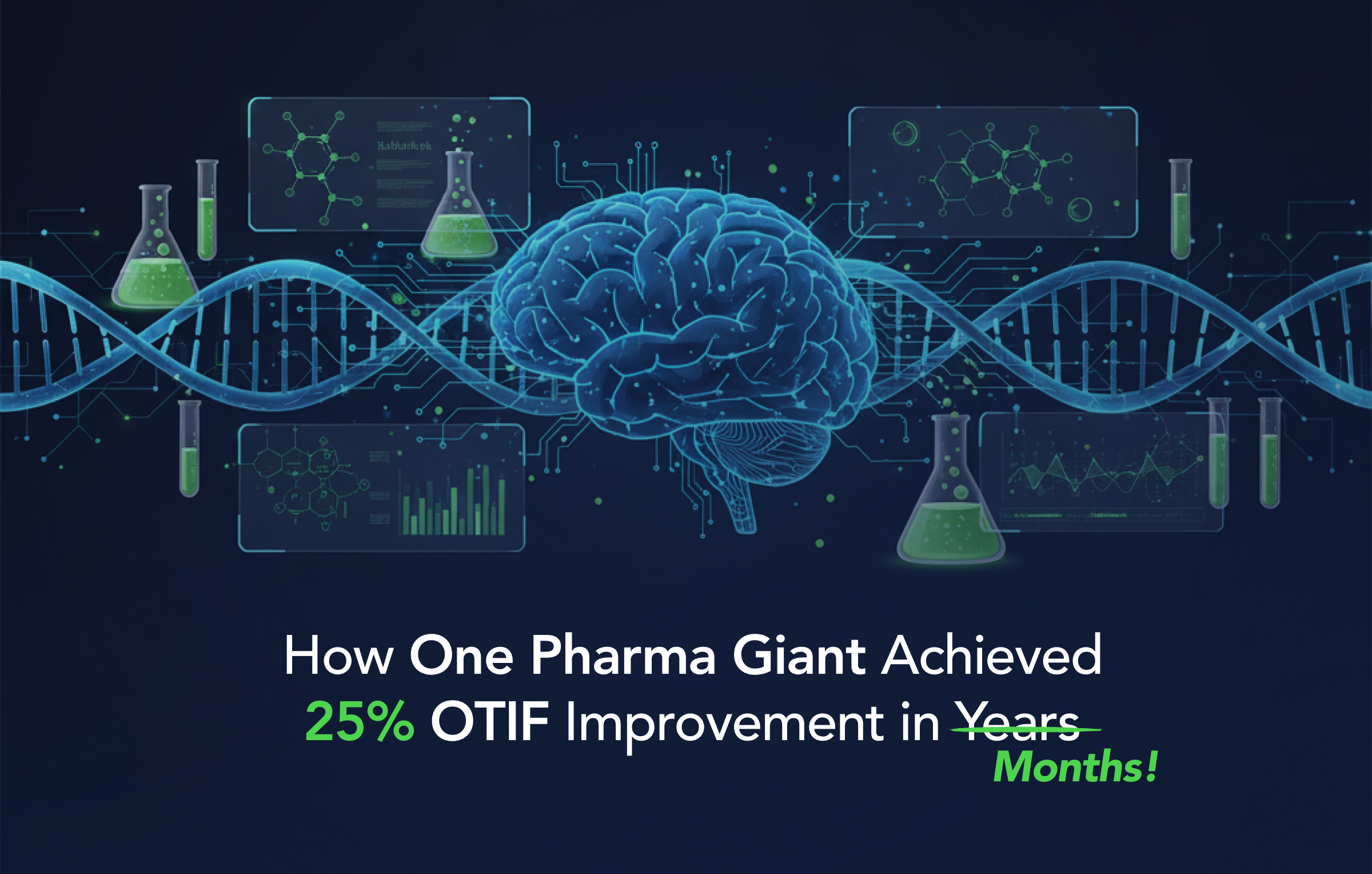

Executive Summary
Pharmaceutical OTIF performance has collapsed from 74% to 28% post-pandemic, directly contributing to an 11% increase in medication errors and 5% rise in patient mortality from drug shortages.
Traditional manual processes and disconnected systems are failing while compliance costs consume 40% of distribution budgets. Retailers demand higher standards with steeper penalties, creating an unsustainable situation.
AI agents provide the breakthrough. At Aligned Automation, our partnership with a multi-billion dollar pharma company delivered:
- 25% improvement in OTIF rates
- 41% increase in customer retention
- 82% reduction in human effort
These intelligent systems autonomously optimize supply chains through real-time data analysis, predictive insights, and automated decision-making.
The question is not whether to adopt AI for OTIF optimization, but how quickly pharmaceutical companies can implement before falling further behind in delivering life-saving medications to patients.
*****************************************************************
Delayed shipments. Incomplete orders. Temperature excursions.
In pharmaceutical supply chains, these failures do not just impact spreadsheets, they can cost lives. When a cancer patient's chemotherapy is delayed or a diabetic cannot access insulin, the consequences of poor on-time, in-full (OTIF) performance become starkly human.
And today's pharmaceutical industry faces an unprecedented supply chain crisis.
Research from IDC and TraceLink reveals that companies achieving OTIF rates of 98% or higher plummeted from 74% pre-pandemic to just 28%. This is not a minor operational hiccup, it represents a fundamental breakdown in the industry's ability to deliver life-saving medications reliably.
Additionally, McKinsey reports that over 50% of executives face higher OTIF expectations from retailers alongside increased fines for non-compliance, creating a perfect storm of rising standards and declining performance.
Yet amid this crisis, a powerful solution is emerging.
AI Agents are transforming pharmaceutical OTIF performance.

Early adopters are achieving remarkable results:
- 25% improvements in OTIF rates
- 41% increases in customer retention
- 82% reductions in human effort through intelligent automation
The question is no longer whether AI can solve the OTIF challenge, but how quickly pharmaceutical companies can implement these solutions before falling further behind.
Let's take a deep dive.
The High Stakes of OTIF Failure in Pharma
According to Gartner, OTIF ranks among the top-tier KPIs in the hierarchy of supply chain metrics that managers must monitor to assess manufacturing and supply chain health.
And for good reason: McKinsey estimates that a 5% to 10% uplift in OTIF can result in a 1% increase in revenue, translating to millions of dollars for large pharmaceutical manufacturers.
But in pharma, the stakes extend far beyond financial metrics.
Research published in JAMA found that drug shortages were associated with an 11% increase in medication errors and a 5% increase in patient mortality in affected therapeutic areas.
The pharmaceutical industry faces unique OTIF challenges:
- Temperature-sensitive biologics require precise cold chain management.
- Regulatory serialization requirements add complexity, while just-in-time inventory models leave no margin for error.
As McKinsey notes, up to 40% of pharmaceutical distribution costs stem from compliance processes, highlighting the operational burden companies face.
But why does this happen?
The Root Causes of OTIF Degradation
The current OTIF crisis stems from systemic issues that have compounded over time. Poor data infrastructure and limited real-time visibility create blind spots where customer needs cannot be anticipated. Without integrated systems providing comprehensive insights, companies operate reactively rather than proactively.
Manual data processes exacerbate these challenges. Disconnected systems and inconsistent data formats require extensive manual reconciliation, consuming 20 or more hours per week in many organizations. This labor-intensive approach drains resources while introducing human error into critical decision-making.
Deloitte's 2024 survey of biopharma executives found that about half of respondents reported only partial improvements in key areas despite digitalization efforts, including better risk-sensing (50%), enhanced yields (50%), warehouse efficiencies (48%), and cost-effective sourcing (47%).
This suggests many digital investments have not yet delivered anticipated returns, often because they lack the intelligence and integration that AI agents provide.
AI Agents: The OTIF Game Changer
AI agents represent a fundamental shift from traditional automation to intelligent, autonomous systems that can sense, analyze, decide, and act. Unlike static automation that follows predetermined rules, AI agents learn from data, adapt to changing conditions, and optimize decisions in real-time.
At Aligned Automation, we recently partnered with a multi-billion dollar pharma giant to demonstrate this potential. We helped the company implement our integrated, AI-driven solution AAxon to address critical pain points across:
- Product Quality
- Supply Chain
- Price and Value
- Ease of Doing Business
- Innovation
The company deployed three core AI-driven capabilities:
- AI-Driven Data Extraction and Analysis: Custom-built AI agents (AAxon AI) aggregated and analyzed data from multiple sources, enabling data-driven precision that led to sharper supply-demand alignment. This automated approach eliminated manual inefficiencies while providing actionable insights for decision-making.
- Enhanced Customer Satisfaction: By leveraging Network Forecast Score (NFS) analytics, the solution enabled sentiment analysis and workflow orchestration across key business functions. This capability allowed targeted, strategic offerings that increased customer engagement and improved revenue growth.
- Improved Data Visibility: KPI dashboards integrating the Vitality Index provided real-time insights into newly commercialized product performance, enabling rapid assessment and response to market dynamics.
The results were transformative, as the company achieved:
- 25% improvement in OTIF rates through enhanced data extraction and predictive insights.
- Customer retention increased 41% as dashboard-driven KPI analysis enabled more responsive service delivery.
- Most impressively, the solution achieved an 82% reduction in human effort by deploying self-learning AI agents that automated manual tasks previously required for data reconciliation and cleaning.
But do you know that most organizations fail to experience these benefits, despite AI implementation? Why? Because of a lack of proper strategy.
Strategic Implementation for Maximum Impact
Successfully implementing AI agents for OTIF optimization requires a structured approach. Gartner reports that 65% of supply chain leaders view adapting to new technology as the most consequential strategic shift over the next five years, with 52% singling out AI as the standout disruptor.
Organizations must start with unified data architectures that harmonize disparate sources into accessible formats. Real-time integration capabilities enable AI agents to access current information from ERP systems, warehouse management platforms, and logistics applications. Strong data governance ensures accuracy and compliance throughout the process.
Deloitte's 2024/5 Global TPRM Survey highlights that 42% of respondents believe AI-enabled automation could reduce their financial exposure following third-party disruption by at least 20%. However, the survey also emphasizes the importance of responsible AI implementation, with top concerns including inaccuracy, confidentiality and privacy, and misuse.
Progressive rollout strategies work best. Organizations should identify workflows with the greatest automation potential, then systematically expand AI capabilities. This measured approach allows teams to build expertise while demonstrating value through quick wins. Deloitte's recent survey shows that 60% of biopharma executives are monitoring generative AI or digital advances closely, with about that same number planning to increase generative AI investments, suggesting companies are moving beyond pilot projects to realize value at scale.
The Path Forward
The pharmaceutical industry stands at a critical inflection point. Patient outcomes depend on reliable, timely access to medications, yet traditional supply chain approaches increasingly fall short. AI agents offer a proven path forward, combining predictive analytics, automated decision-making, and real-time visibility to transform OTIF performance.
The evidence is compelling. Companies implementing AI-driven solutions achieve higher OTIF rates, improved customer satisfaction, reduced operational costs, and enhanced sustainability. These benefits compound over time as AI systems learn and optimize continuously.
The question facing pharmaceutical executives is not whether to invest in AI for OTIF optimization but how quickly they can implement these solutions.
The future of pharmaceutical supply chains is intelligent, autonomous, and patient-centric. AI agents are not just improving OTIF metrics, they are ensuring that life-saving medications reach patients when and where they are needed. For an industry whose fundamental mission is improving health outcomes, there is no higher priority than getting this right.
Transform Your Ideas into Powerful Digital Solutions

























.svg)




















